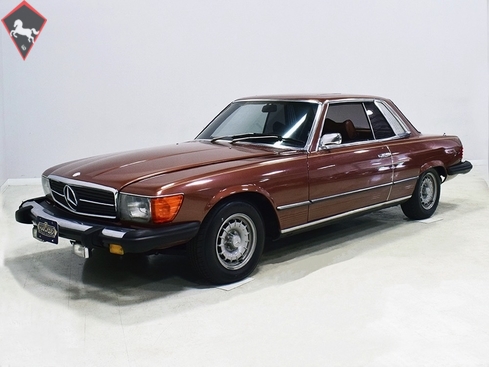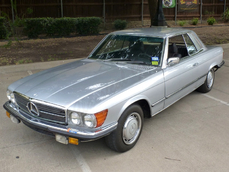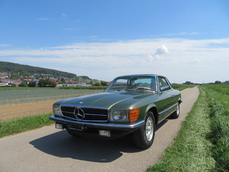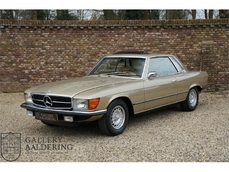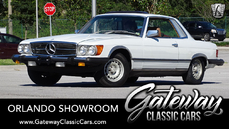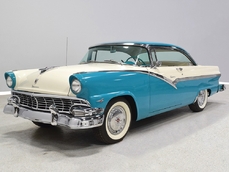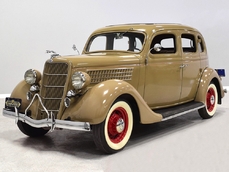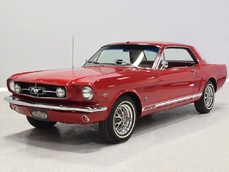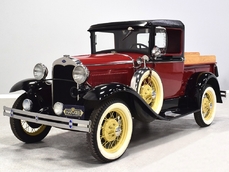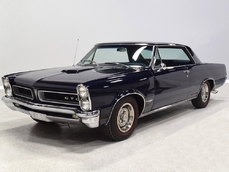Mercedes-Benz 450SLC w107 4.5 liter SOHC V8 1976
Allgemeine Beschreibung :
The Mercedes-Benz 450SLC is a car you’ve probably never seen before. Obviously it’s a sibling to the ever-popular range of R107 SL roadsters, and the platform under the SLC is related, called the C107. It offers all the same good stuff: robust build quality, silky smooth and endlessly torquey V8 engine, handsome good looks that still seem contemporary today, plus one thing the SL never offered: a real back seat. The coupe’s longer wheelbase makes for a reasonably usable rear seat area and a more spacious passenger compartment that changes its personality, but only a little. This is a grand tourer in the best sense of the word, able to consume large swaths of pavement at high speeds in comfort. That is what these cars do best. And they’re a real bargain compared to their open-top siblings, too!
I will admit to having a bit of personal bias, as a 450SLC was in our family when I was younger and I spent a lot of hours behind the wheel as a young driver. The car was always competent, reliable, and fun to drive, and the upscale coupe was certainly appealing to a teenager whose peers were driving Chevettes and VW Rabbits. This handsome Topaz Brown 450SLC is simply a good original car that has lived an easy life. It seems to hail from a warm climate that never had to deal with harsh weather, as there’s no notable rust or damage, and like all Mercedes-Benz vehicles of the era, it fits together extremely well. The doors close with a reassuring THUNK and even the metal door handles feel substantial in your hand. The coupe retains the roadster’s overall look, and the added inches are all behind the door, so it gets that cool quarter window treatment and forward-canted C-pillar that make it look sporting. The long hood/short deck styling works especially well, and if you squint a bit, you might even see a bit of muscle car styling in there. With flared fenders, a bulging hood, and a great V8 exhaust note, it could probably be mistaken for a German Mustang. This particular car also features Euro headlights, which are a BIG improvement over the usual four-eyed stare, and the federalized bumpers look right after 5 decades of looking at them.
From behind the wheel, it’s indistinguishable from the SL roadster. Same supportive bucket seats, same big steering wheel, same easy-to-read gauges. We believe the front seats have been reupholstered, but it was done in such a way so to make it simply look like normal age and fading may be in play, so it fits in with the rest of the interior. The MB-Tex in back is a little dry and there’s one split seam, but it isn’t very noticeable and we’d leave it alone. The carpets are surely original, as are the door panels and headliner, all of which are in good condition. The gauges are all operational, the sunroof slides open smoothly, and there’s a newer JVC AM/FM/cassette head unit in the dash, along with what appears to be a microphone for dictation—a relic of the car’s life in the late ’70s. There’s also a CB radio, although we haven’t tried to see if it works. The car was apparently sold and serviced by a Cadillac dealer, which explains the engraved Cadillac nameplate on the dash but we don’t believe the owner was anyone of note. The A/C appears operational but does not blow cold and since it’s an R12 system we have chosen to leave it alone rather than convert it. Even the power antenna goes up and down as it should. The trunk is neatly upholstered with gray carpet, and the original spare tire and jack assembly are included.
Mechanically, the SL and SLC are identical, and in 1976 both were powered by Mercedes’ rugged and wonderfully flexible 4.5 liter SOHC V8. On paper, the 180 horsepower and 220 pounds of torque seem modest, but in the real world this car always feels like it is on the end of a giant recoiling rubber band. That bubbly, smooth, torquey V8 feels like it could pull forever and it never seems to be working very hard. There’s a precise mechanical feel to it that’s also quite appealing—not the isolation to which we’ve become accustomed to today, but rather the feeling of a very expensive piece of machinery doing its thing. There’s a nice V8 burble out back from the recent exhaust system, and thanks to fuel injection, it always starts and idles well. The engine bay is dominated by the giant air cleaner housing and aluminum cam covers, so it should look familiar to anyone who has own a 107-series Mercedes in the past. There are plenty of signs of maintenance throughout and some new components, and the car drives well with no major issues. It’s happy to trundle around town where it dices effortlessly with traffic or blasts down the interstate at supra-legal speeds without breaking a sweat. This is still the Mercedes for people who enjoy driving.
Underneath you can see that this car has never spent time in the harsh snow and salt areas. It isn’t perfect, of course, but the floors, subframes, and rocker panel areas are solid and undamaged. The only notable rust is a finger-sized hole in the battery tray, which shouldn’t be a surprise. The 3-speed automatic transmission was the only option in 1976 and it shifts smoothly and imperceptibly, but offers a quick downshift when you stab the accelerator—this car feels like it’s always on its toes. Out back, the independent rear end carries 3.07 gears, which are tall enough to be quiet and comfortable on the highway but allow the SOHC V8 to get into its sweet spot quickly. The suspension is more luxury than sport, but it’s confident and easy to handle, especially with power steering and brakes being part of the equation. And those brakes are 4-wheel discs that are quite effective. You’ll also note a newer exhaust system, recent fuel pumps, and signs of recent work throughout. Traditional Mercedes-Benz “bundt cake” alloys have been recently refinished and carry 205/70/14 blackwall radials.
These cars have been living under the radar for decades. They’re fast, smooth, competent, and if you have a family, not a bad choice. Add in the legendary durability of the 107 platform, the relative rarity of the body style, and the bargain price, you get a hobby car that’s easy to buy, own, and live with. Or drive it every day—you’ll be thrilled with how modern it feels even 40 years after it was born. Call today!
Harwood Motors always recommends and welcomes personal or professional inspections of any vehicle in our inventory prior to purchase.
http://www.harwoodmotors.com/vehicles/inventory_details.php?id=1213
1976 Mercedes-Benz 450SLC w107 4.5 liter SOHC V8 is listed verkauft on ClassicDigest in Macedonia by for $9900.
Fakten der Auto
Karosserietyp : Auto Marke : Mercedes-Benz Modell : 450SLC w107 Ausführung : 4.5 liter SOHC V8 Hubraum : 4.5 Modelljahr : 1976 Lage : Ohio
Verkauft
Angaben Zum Verkäufer
Verkauft
People who viewed this Mercedes-Benz 450SLC w107 also viewed similar Mercedes-Benz listed at ClassicDigest
Other cars listed for sale by this dealer
über Mercedes-Benz
In den Annalen der Automobilgeschichte entfaltet sich die Reise von Mercedes-Benz wie eine Erzählung voller Ingeniosität seiner Gründer. Im Jahr 1886 schuf Karl Benz den Benz Patent Motorwagen, eine Kreation, die als das weltweit erste Automobil in die Geschichte eingehen sollte. Unwissentlich markierte dieser Moment den Ursprung dessen, was sich zu einem weltweit renommierten Premium-Autohersteller entwickeln würde. Die finanzielle Basis dieses bahnbrechenden Unternehmens wurde interessanterweise von Karls Ehefrau, Bertha Benz, bereitgestellt, was eine bemerkenswerte Partnerschaft demonstrierte, die den Ton für das Erbe von Mercedes-Benz setzen sollte.Nicht weit entfernt entstand eine parallele Erzählung, als die Daimler-Motoren-Gesellschaft, gegründet von Gottlieb Daimler und Wilhelm Maybach, die Bühne betrat. Im Jahr 1901 enthüllten sie ihr Auto unter dem mittlerweile berühmten Namen "Mercedes", was auf Spanisch "Geschenk Gottes" bedeutet. Dieser Name wurde auf das Auto auf Wunsch von Emil Jellineks Tochter verliehen, dem Vertriebspartner der Daimler-Motoren-Gesellschaft. Die Räder der Innovation wurden in Bewegung gesetzt.
Springen wir vorwärts ins Jahr 1926, ein entscheidendes Jahr, das die Fusion von Daimler mit Benz & Cie. sah, was zur Geburt von Daimler-Benz führte. Die Fusion führte zur Übernahme von "Mercedes-Benz" als das renommierte Markenzeichen für ihre Automobile und verschmolz die Legenden zweier visionärer Unternehmen zu einer.
Entgegen konservativen Wahrnehmungen entfaltet sich die Geschichte von Daimler-Benz als Chronik von Branchenneuheiten. Von der Einführung des Wabenkühlers über den Schwimmervergaser bis zur bahnbrechenden Einführung von Vierradbremsen im Jahr 1924 trieb Daimler-Benz kontinuierlich die Grenzen der automobilen Innovation voran. Der Dieselantrieb des Mercedes-Benz 260 D im Jahr 1936 markierte den Beginn von Dieselmotoren in Personenkraftwagen. Der ikonische Mercedes-Benz 300SL Gullwing schrieb Geschichte als das erste Auto mit direkter Kraftstoffeinspritzung, wenn auch der winzige 2-Takt-Motor des Gutbrod Vorrang beanspruchen kann.
Sicherheitsinnovationen wurden zum Markenzeichen, mit Béla Barényis patentiertem Sicherheitszellen-Design in den "Ponton"-Modellen im Jahr 1951, das Front- und Heck-Knautschzonen umfasste. Der W116 450SEL 6.9 führte die Einführung des Antiblockiersystems (ABS) ein, eine weitere wegweisende Sicherheitsfunktion. Vom ersten serienmäßigen Airbag bis hin zu vielen weiteren Innovationen wurde das Erbe der "Ersten" weiter in das Gewebe von Daimler-Benz eingeschrieben.
Auf seiner über hundertjährigen Reise hat Mercedes-Benz nicht nur Autos produziert, sondern automobile Ikonen geschaffen. Der SSKL, 710 SSK Trossi Roadster, 770K Grosser, 540K Spezial Roadster, 300SL Gullwing, W100 600 Pullman, W111 280SE 3.5 Flachkühler, W113 230SL Pagode, W109 300 SEL 6.3 und W201 2.3-16 Cosworth sind Zeugnisse des Engagements der Marke für Ingenieurkunst.
Die donnernden Silberpfeile, oder "Silberpfeile", darunter der W 25, W 125, W154, W165 und W196, schufen ein Erbe der Dominanz auf der Rennstrecke. Diese Maschinen waren nicht nur Autos; sie waren Ausdruck von Präzision, Geschwindigkeit und einem unbezwingbaren Geist, der die Konkurrenz im Staub zurückließ.
Während Mercedes-Benz in die Zukunft schreitet, tut es dies nicht nur als Automobilhersteller, sondern als Hüter eines Erbes, als Fackelträger der Innovation und als Leuchtturm automobiler Exzellenz. Der Weg in die Zukunft wird zweifellos die Fortsetzung der Verschmelzung von modernster Technologie, zeitlosem Design und dem unerschütterlichen Engagement für die Festlegung neuer Standards in der Welt der Automobile erleben.
